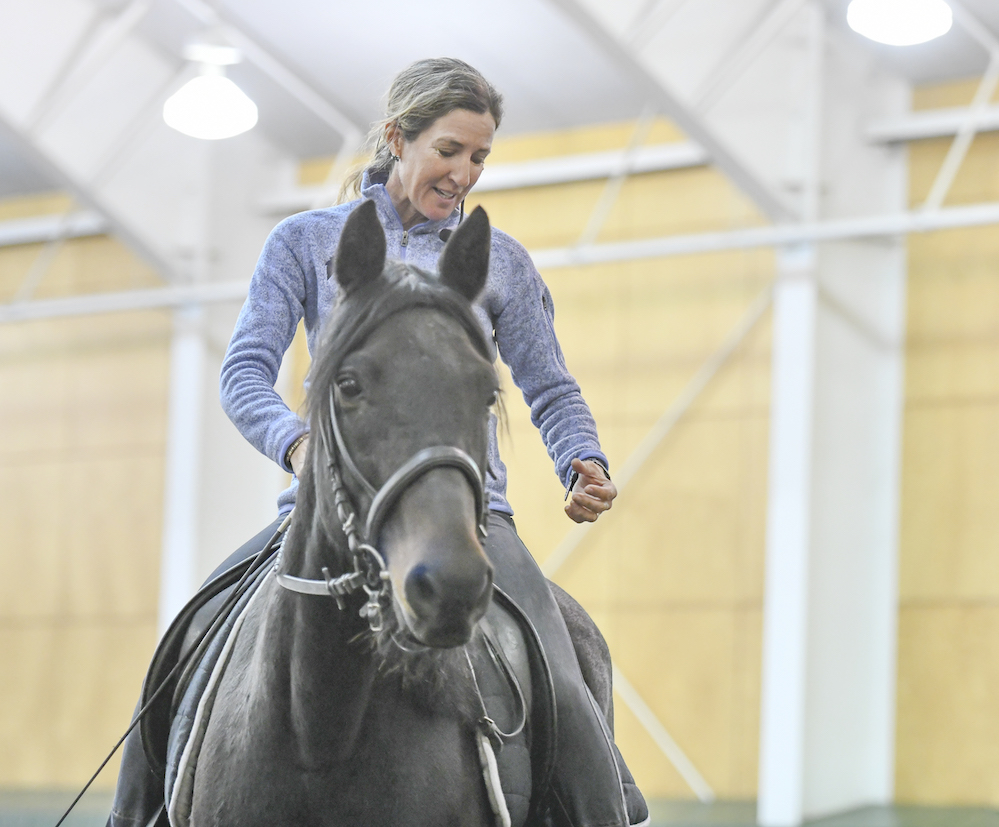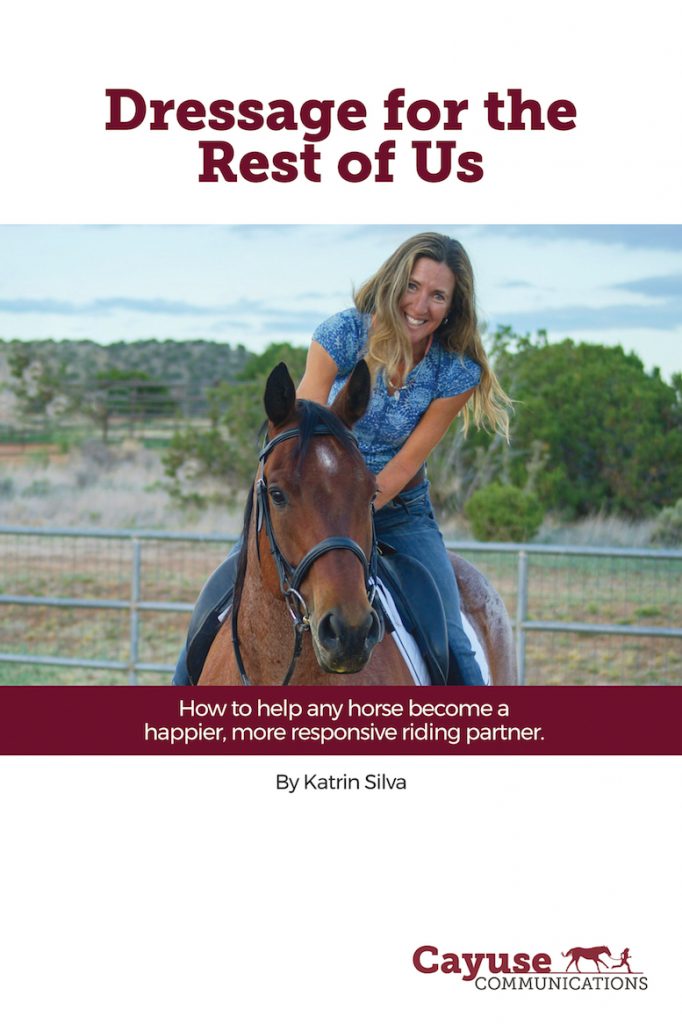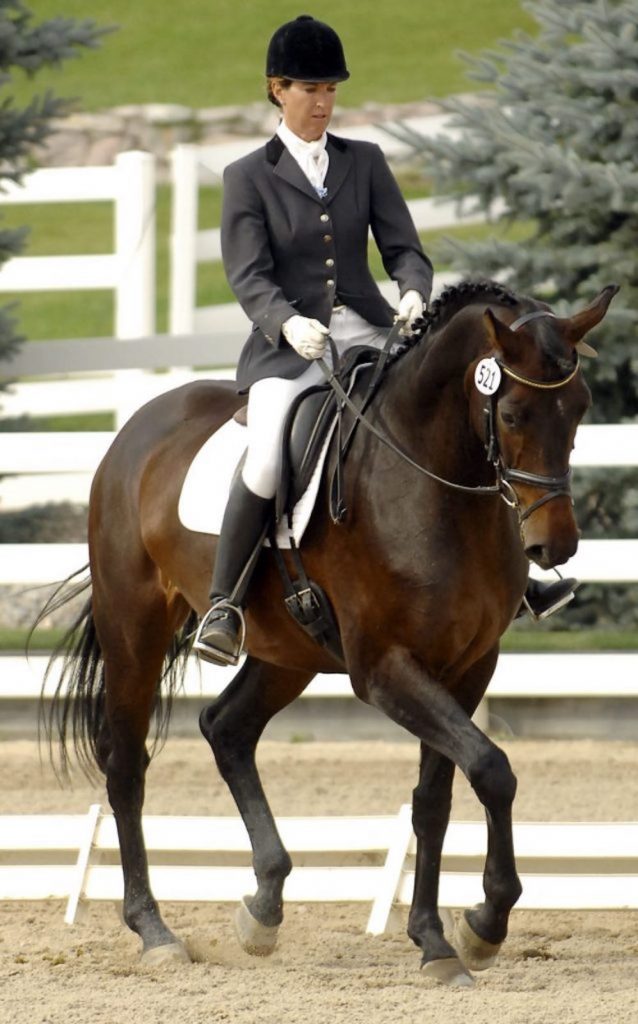Editor’s Note: Best Horse Practices Summit presenter Katrin Silva grew up riding dressage in Germany before moving to the United States at age 19 to learn to ride Western. She’s been riding both disciplines for the last twenty years and is a regular guest columnist for Cayuse Communications. She lives in New Mexico where she works with dressage and Western clients. Visit her blog here.
Buy her book, Dressage for the Rest of Us here.

Katrin Silva at the 2019 Summit. Photo by Nina Fuller
Katrin Silva writes:
I’ve built my reputation as a trainer of horses who are no one’s idea of good dressage prospects. Their owners love them, but most of these horses are not bought or bred for the purpose of competing at a high level. They have physical or mental baggage, sometimes both. I help them with behavioral issues and I give green horses correct foundations.
This year, though, through a lucky set of circumstances, I am working with a few young horses born to do dressage. I feel grateful for this opportunity, but I’ve learned something surprising: training a promising, willing youngster without baggage is not as easy as it sounds.
It’s true that the actual training process tends to be smoother with a horse who finds dressage easy. When I introduce a new exercise, I hear them say:
“Oh, this is what you mean?” instead of “This is really hard . . . could you break it down into smaller steps?” or sometimes an outright “No, I can’t do that!”
Dressage is, of course, good for all horses, but teaching connection and straightness to an off-the-track thoroughbred with an upside-down neck and all the wrong muscles takes more time and patience than doing the same work with a young horse bred to it.
 But here are the surprising challenges:
But here are the surprising challenges:
It can be tempting to take shortcuts on a talented, willing horse. One could get away with it, at least for a while. On a horse with a perfect neck and naturally swinging back, it’s tempting to rush through these important stages. After all, tests at second level and above don’t require a stretchy circle, so why should I ask my horse to stretch?
A horse with conformation issues like a low-set neck or a downhill build will not become a real athlete unless I spend the time it takes to build correct muscles and teach suppleness and balance. And a horse with behavioral issues like bolting or bucking must learn to relax his mind and body. A tense horse must learn to move freely forward in a stretched frame, otherwise correct contact will be impossible.
For horses with these physical or mental challenges, there is no way around this slow, gradual process of building (or rebuilding) their body, mind and spirit. The bottom steps of the training scale need to be confirmed before we can move ahead to “real” dressage work like half passes or flying changes.
On a born-to-dressage, baggage-free horse, it’s tempting to move right into advanced movements, without confirming that the horse understands how to trust his rider or how to accept an elastic connection with the rider’s hands. It’s easy to take rhythm, suppleness, and a steady tempo for granted if they seem like no big deal.
But talent is a loan that has to be repaid, not a gift to do with as I see fit. The holes in a horse’s training will eventually show. From working with horses who were hurried through their basic education, I know these holes can sometimes be irreparable.
 Because I’ve seen what shortcuts do to a talented horse, I make every effort not to take them. A talented horse is not a ticket to show ring success. Helping a talented horse reach his potential is a big responsibility.
Because I’ve seen what shortcuts do to a talented horse, I make every effort not to take them. A talented horse is not a ticket to show ring success. Helping a talented horse reach his potential is a big responsibility.
So, I’m enjoy my talented youngster sand realize that without all the complicated, perplexing horses I’ve trained, I would not do them justice. I’ve competed on those less talented horses who have surprised their owners, and me, with how far they could go. (By the way, it’s also a lot less stressful to enter at A on a horse no one expects to do well. If he doesn’t place, no one cares. If he does, it’s cause for celebration!)
Working with difficult horses keeps me humble. Working with a variety of horses keeps my training honest, my life interesting, and my horizons expanding. I will make sure to give the baggage-free, born-to-dressage horses as sound a foundation as all the others. After all, horses don’t owe me anything. I owe them everything.
I enjoyed your article. I noticed in the picture you are riding with a dropped noseband. Can you explain the benefits of this to developing a horse?
Hi Jill, never use dropped nosebands. I am using a flash noseband in on of the pictures. It was taken about ten years ago at a recognized dressage show, when most riders used a flash noseband (they still do, but not to the extent they did in those days). I was trying to look like a “real” dressage rider, which was not a good reason to use a flash. Nowadays, I rarely use this type of noseband, and only when I need to steady the snaffle in the horse’s mouth, which some horses with severe contact issues need. Over time, they learn to accept contact, which helps them develop connection, straightness, impulsion, and ultimately collection and lightness. Every horse should eventually reach a point where a noseband is no longer necessary. Does this answer your question? Please let me know!
What a great article. It is timely because I’m in the process of training two different horses with different mental and physical attributes. One shoulder Off The Track horse and one younger horse with a great mind. I appreciate the fact that each come with different baggage and that some things are irreparable. You can’t fix everything. Thank you
Dale, I wish you good luck on your journey with these two horses. You will learn a lot from both!
Love this. “Talent is a loan that has to be repaid, not a gift to do with as I see fit.” Beautifully said.
Thanks for another wonderful article. I’m looking forward to helping my not-bred-for-dressage horse to learn the dressage training scale to help him be a supple and balanced horse.
Dressage is for all horses, no exceptions. Your horse will thank you! Enjoy the jounrey.
Thank you, Caryl!